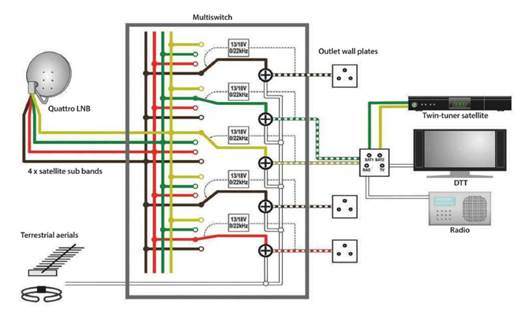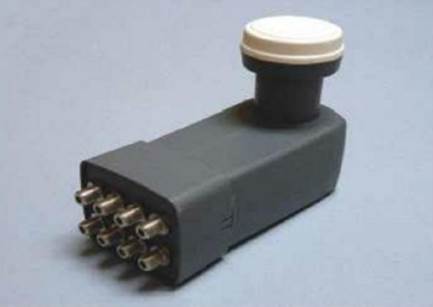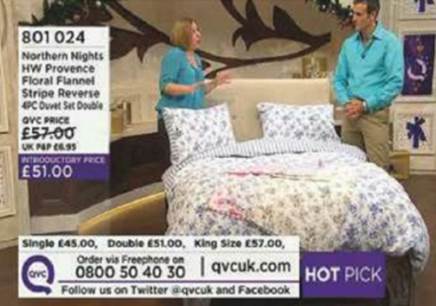Multi-switch system
A multi-switch is not as complicated as it
may first appear. In essence, all it does is to take the selection of the
satellite sub-band away from the LNB and handle that itself, along with
splitting and distributing the signals. This diagram of a multi-switch IF
distribution system (a v actually includes all manner of signal buffering and
amplification which is not included here) shows how the required sub-band is
switched through to each outlet.
The four sub-bands of the satellite
spectrum are supplied separately and continuously by the Quattro LNB. These are
each split to potentially supply all of the outputs with each sub-band. The
sub-band actually supplied to each output is determined by the 13/18V and
0/22kHz signals on the cable (from the receiver) connected to that output.
Before the selected sub-band is supplied to each multi-switch output, the
terrestrial signal is also added to it so the output carries one satellite
sub-band and the terrestrial frequencies.
To each satellite receiver connected to the
multi-switch output (via a triplexed wall plate to ‘strip off’ the terrestrial
frequency signals) the output appears to be directly connected to a single
output LNB – it supplies the whole reception sub-band in response to the
voltage and 22kHz tone sent by the receiver ‘up’ the cable independent of
whatever the multi-switch’s other outputs may be supplying.

Multi-switch
system
1. First, you must decide if you really need a multi-switch system.
Quad and octo LNBs (pictured) can provide up to eight outputs direct to the
receivers and may be sufficient for many needs. However, if you need more
outlets, terrestrial TV and radio distributed as well, or simply can’t handle
eight cables entering the building from the dish, a multi-switch is the answer.

First,
you must decide if you really need a multi-switch system
2. Select your multi-switch with care. However many outputs you think
you need, you will probably end up wanting more. Remember that twin tuner
receivers, such as Sky+ and Freesat+, need two LNB feeds and so will each take
up two of the multi-switch outputs. Getting a multi-switch with more outputs
than you need now will give you some leeway in the future.
3. While a few multi-switch can connect to a ‘normal’ quad LNB (the multi-switch
continuously supplies the 13/18V and 0/22kHz signals to select the required
sub-band for each LNB output) most require a special Quattro LNB. This supplies
each of the four sub-bands from its four outputs. It does not respond to normal
13/18V and 0/22kHz signals from the receiver and cannot be used with a receiver
directly.

The
multi-switch continuously supplies the 13/18V and 0/22kHz signals to select the
required sub-band for each LNB output
4. Many multi-switch introduce some signal losses into the signal chain
to the receiver, and so a larger dish than that normally used may be required.
It’s not a bad idea to use a larger dish anyway, so you can be sure of it
working in all weathers. Go for one dish size up from ‘normal’ – a 60cm dish
where a 45cm one is normally used, an 80cm instead of a 60cm, ect.
5. If you have aerials for TV, FM and DAB, the signals must be combined
to feed into the single input of most multi-switch. You can use a cheap Y-type
aerial splitter, but you’ll be better off in the long run with a proper
triplexer, or combiner, such as the Vision V24-310. This has a waterproof box
for fitting outdoors (to be close to the aerials) and also passes a DC supply
to a TV aerial masthead amplifier if necessary.

You
can use a cheap Y-type aerial splitter, but you’ll be better off in the long
run with a proper triplexer
6. Choose a place in the home for the multi-switch. Ideally, this
should be roughly central as regards the outlet wall plates, reasonably close
to the dish (it’s advisable to keep the dish multi-switch cable runs as short as
possible, not more than about 10m), out of the way, and close to a mains power
outlet. The loft is often used, or an under stairs cupboard can make a good
‘media hub’.
7. Use good quality coax cable between the dish and the multi-switch,
and make sure you know which cable is which at both ends – either run each
cable separately and carefully label it at each end, or use differently colored
cables. The convention (worth sticking to) is Yellow: horizontal high band,
Green: horizontal low band, Red: vertical high band, Black/brown: vertical low
band.

Use
good quality coax cable between the dish and the multi-switch
8. Finding a suitable route for at least four cables (the terrestrial
aerial cable may take a different route) to the multi-switch is not always easy
if the run is to be both short and discreet. Entry into the building can be as
‘normal’ through holes drilled through the wall, into the loft via the soffits
or even taking advantage of a route under flashing on a chimney or parapet
9.
Inside the home, if the multi-switch is in the
loft then the cables can go direct to it without too much thought to their
aesthetic impact. If the route takes the cables vertically or horizontally
through the building, then it is as well to tuck the cables out of sight –
under floorboards or behind the plasterboard. If the cables must go on the
surface then enclose them in Trunking or box around them.
10. If you haven’t used colored cables, or labeled the cables from the
LNB, you can identify which is which by connecting up a receiver to each cable
and seeing what channels are available. For a dish pointed at 28.2oE, access to
the following FTA SD channels identifies the four sub-bands: Sky News: vertical
high band, QVC: horizontal high band, Channel 5: horizontal low band, Euronews:
vertical low band.

If
you haven’t used colored cables, or labeled the cables from the LNB
11. Even if your multi-switch serves just your own household, it is a
good idea to earth it for safety. If it’s not earthed through its mains
connection (they usually have a two-core mains lead only), the earth screw on
the casing should be connected to a suitable nearby earth point, if you know
this is properly functioning, or directly to the earthing block at your
fusebox/consumer unit, if in any doubt, always consult an electrician.
12. When you’ve finished connecting up the multi-switch you should have
a neat and ordered installation that will both deliver the results wanted, and
be easily attended to in the future if required. Now it’s time to attack the
wall plates at each outlet and the wiring to them and that’s what we’ll be
looking at next month.

When
you’ve finished connecting up the multi-switch you should have a neat and
ordered installation that will both deliver the results wanted